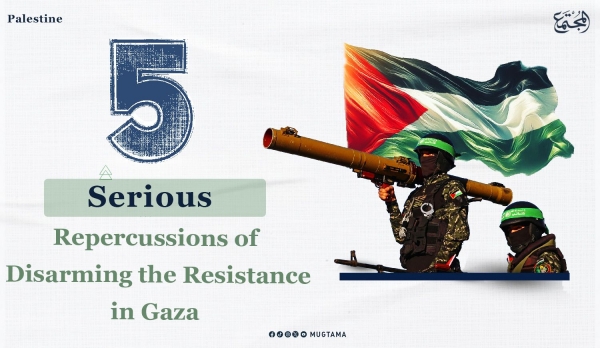5 serious repercussions of disarming the resistance in Gaza Palestine
In the midst of the political efforts being made to stop the ongoing Israeli aggression against the Gaza Strip, a proposal has emerged from the Egyptian mediator to the Hamas movement, which includes a ceasefire in exchange for entering into arrangements that would lead to the disarmament of the resistance.
Despite the promises this proposal carries of comprehensive calm and reconstruction, it touches upon one of the strategic pillars that has formed, over the years, the sole element of balance in the equation of struggle against the occupation.
The resistance's weaponry in Gaza was not just a military tool, but rather a cornerstone of deterrence that prevented the reoccupation of the sector or free incursions into it, imposing battlefield equations that repeatedly confused the calculations of "Tel Aviv.
From here, any step towards disarming this weapon – whether by force or through a political agreement – cannot be separated from the broader context of the Zionist project in Palestine, nor from the strategic objectives of the occupation in both Gaza and the West Bank.
Here is a presentation of the most significant consequences resulting from such a procedure:
- The collapse of the deterrence system in the face of occupation:
For years, the Palestinian resistance in Gaza has accumulated missile and security capabilities that have created a real deterrent against the occupying army. Every attempt at aggression against Gaza has been met with a direct response that disrupts security and political calculations in "Tel Aviv.
The removal of this weapon simply means the fall of the only deterrent that the resistance possesses, and the return of the occupation to act with complete freedom towards Gaza, whether through military incursions or field assassinations. With the absence of weapons, any civil or popular resistance becomes incapable of confronting these violations, leading to the opening of a new phase of direct or indirect Zionist domination over the sector.
- Enabling the occupation to politically and security-wise re-engineer Gaza:
Through disarmament, the occupation seeks to reshape the internal landscape in Gaza to align with its interests. In the absence of the resistance's power, the Zionist entity can push for a governance model that subjects the sector to a local administration that is under security coordination or regional and international oversight, with the aim of controlling the population without any security threats.
In this way, Gaza is transformed from a resistance environment into a demilitarized buffer zone, subject to political and security control through soft tools, such as conditional humanitarian aid or reconstruction in exchange for lasting calm.
- Deeper internal Palestinian division and loss of national balance:
Any disarmament process without comprehensive national consensus means igniting internal conflicts, as the parties that accept this step will be accused of abandoning the option of resistance in exchange for temporary political or economic gains.
The absence of resistance in Gaza, while the West Bank remains under security coordination, leads to the end of the national resistance project in favor of the "state under occupation" project. This causes the Palestinian people to lose trust in their leadership and deepens the geographical, political, and psychological division between the West Bank and Gaza.
- Turning the Palestinian issue into a purely humanitarian file:
The resistance weapon is considered one of the enduring symbols of the liberatory character of the Palestinian cause. Disarming this resistance means stripping the cause of its political and struggle-oriented essence, reducing it to merely a humanitarian crisis related to services, crossings, water, and electricity.
Thus, major issues—such as the liberation of Jerusalem, the right of return, and the end of occupation—are marginalized, and are replaced by conditional life gains that are presented as an alternative to liberation in exchange for silence about resistance.
- The loss of Gaza's symbolic status as a stronghold of Arab and Islamic resilience.
Over the past years, Gaza has become a symbol of resilience and dignity in the Arab and Islamic consciousness, thanks to its steadfastness in the face of aggression and its ability to impose deterrent equations despite the blockade.
Disarming it would eliminate this symbolism and open the door for a new Zionist narrative that promotes the idea that what the military has failed to achieve can be accomplished through economic and international pressure.
Over time, the moral presence of Gaza in the collective Arab consciousness will fade, replaced by discourses of realism and economic peace, leading to an erosion of grand concepts such as liberation and resistance.
Read also: Resistance Weapon... A Power Equation at the heart of Negotiation


